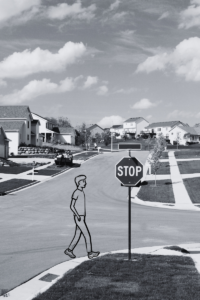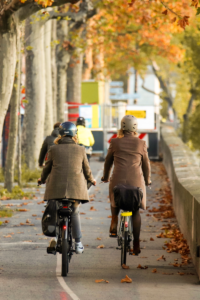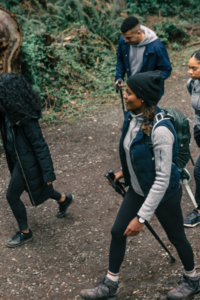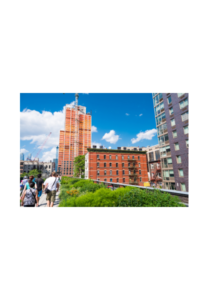Walking in the Suburbs: The challenges and tribulations of being a weird bipedal creature in a car-dominated limbo

The United States has been a car-dominated culture since the 1950s. However, when you are from a dense city such as New York, you don’t fully realize this. My family never owned a car and I didn’t drive regularly until well into my 20s. As someone with a nomadic lifestyle for the last ten years, I’ve lived in a wide variety of settings – as a walker, driver, public transportation rider, or some combination of the three. Wherever I go, I still look at the world primarily through the eyes of a walker.
I prefer the word “walker” to “pedestrian.” The latter seems too long and
technical a word for such a normal activity. After all, getting around on foot was the norm for most of history. But now it’s the driver who is considered normal. Walking is now for children in the playground, seniors going on their daily constitutional, or what you do after parking your car and heading into the mall.
Where Walking is Weird
Nowhere is walking more of a fringe activity than in the suburbs, which, tragically, encompass more and more space on the planet. The following are a few random impressions and issues.
- Walking in the suburbs, especially alone, without a dog, seems borderline weird. I suspect if I walked around alone at night, a neighborhood watch group might start tracking me.
- In some places, I have the sense of trespassing even on public sidewalks. Dogs frequently bark at me from behind fences or from within houses.
- In some places, sidewalks simply vanish and re-emerge from one block to the next. One minute I’m walking on what seems like a city sidewalk, the next I’m in the road watching for traffic.
- Suburban sidewalks are often extremely narrow, making it awkward when you pass someone walking towards you, especially (as is often the case in the burbs) they are a couple or family and/or have dogs or a baby stroller. Jane Jacobs addresses the issue of sidewalk width in books such as The Death and Life of Great American Cities.
- During winter, in places that get snow, not everyone bothers to shovel and you may be trudging through thick slush or even solid ice. Some homeowners seem to think a “slippery surface” sign is a sufficient substitute for maintaining their property.
Or Are Suburbs Actually Weird?
I can never get past the notion that it’s actually suburbs that are weird. We can trace back the history of cities thousands of years (villages, which are basically micro cities, go even further back). Some cities, such as London, have a continuous history going back over a millennium.
Over the centuries, things have changed a great deal. But people walked around medieval London and Paris and ancient Rome, Alexandria, Constantinople, and Beijing. They still do, with the main difference being that traffic is now motorized rather than consisting of horses, camels, or donkeys. The suburb, a radical break from all this walking, didn’t make its appearance until the 20th century. The first large scale suburb is usually considered to be Levittown, on Long Island, which started in 1947. But now we’re supposed to think it’s normal to drive everywhere and be surrounded by anomie-inducing sprawl.
Politeness: A Double-Edged Sword
On average, suburban drivers are more polite to walkers than urban drivers. New York City, possibly the most pedestrian-oriented place in the world, is infamously rude. Every pedestrian crossing represents a battle between walkers and turning cars. By contrast, many suburban drivers will politely let you cross the street rather than trying to speed past you. How could anyone object to this?
First of all, a small percentage of drivers are not so polite, or in some cases distracted or outright aggressive. In the last 5 years or so, I’ve been almost run over in Houston, Denver, and the East Bay area by drivers who either didn’t see me or felt it was my problem to get out of the way. So we can never count on drivers being considerate, even if the majority are.
As a rule, politeness is better than its opposite. However, it also can suggest condescension and, most of all, otherness. In a busy city, walkers are just as aggressive as motorists and hold their own. In New York and other cities, it’s common for walkers to gang up on drivers. If 10 people, in unison, start crossing the street, even against the light, what can the driver do but wait? I’m not saying this kind of behavior should be encouraged, only that it illustrates the power of pedestrians in a city. By contrast, in the suburbs, a pedestrian is an exotic, helpless, and borderline handicapped creature. We depend on the consideration of drivers.
There’s also the issue that many suburban drivers don’t have the kind of instinctive sense of timing that city drivers develop. For example, if I am just starting to cross a street, a turning driver can usually finish long before I am close to them. However, some will wave me across, which makes me feel pressured to move faster to get out of their way. In such cases, politeness causes rather than alleviates a walker’s convenience.
Walkers vs Bikers

On the surface, it might seem that people walking and those riding bicycles are natural allies, both (at least at times) choosing non-motorized means of transport. Unfortunately, this is not always the case.
Regardless of local laws, many people on bikes (as well as motorized scooters) routinely ride on sidewalks as well as trails. It seems that ever since Lyme and other bike and scooter sharing services got started, the unwritten rule has been “ride anywhere you want.”
Of course, one reason for this is that many areas don’t have bike lanes so riding in the street isn’t safe. The result is that there are fewer and fewer places exclusively for walking. So bikes and people on foot are forced to compete for ever-diminishing space.
One increasing issue on both trails and sidewalks is that motorized bikes and scooters are now everywhere. Many e-bikes can travel at 40 mph, as fast as cars in dense urban areas. So, as a walker, you now have to share space with motorized vehicles.
Remember that e-bikes, though they’ve been around for a while, are just starting to take off as a popular form of transport. According to Grand View Research, the e-bike market was close to $2 billion in 2022 and is expected to grow 15% annually until 2030. The use of electric scooters is growing at a similar rate. This may not be astronomical growth, but it means more and more motorized vehicles competing for already limited pedestrian space on sidewalks and trails.
Green Spaces vs Walkability

Urban trails have sprung up all over the United States. For example, the East Bay Greenway runs parallel to the BART system and connects Berkeley, Oakland, Richmond, and other cities. Like most trails, these are shared by walkers, bikers, and people on scooters.
Denver is a good illustration of how you can have lots of trails and parks while not being pedestrian friendly (with the exception of the actual downtown, which has seen declining use with rising crime and homelessness). The rest of the city is very spread out, hard to reach via public transportation, and dominated by sprawl.
The Denver Parks & Recreation page boasts that the city has “nearly 20,000 acres of urban and mountain parkland including off-street trails, parkways and natural areas.” It’s true, in the Denver metropolitan area, you are almost always within a short walk of a green space. It’s true, trails and parks are everywhere. That doesn’t equate to a walker-friendly city.
Walkability, a concept often discussed by urban planners, is more than simply having places to walk. A walkable area is one where you have places to walk to, such as stores and other destinations. The trails in Denver are great but as soon as you leave the trail, you’re usually back in the limbo of sprawl or, at best, residential neighborhoods. Green spaces such as trails and parks are not a substitute for walkable downtown areas where you can actually do things apart from walk.
There are trails that connect with downtown, but these are often 5 miles or more from most suburbs. Most of the trails, while nice for taking a leisurely walk (or bike ride), don’t really lead anywhere people need to go, such as work, school, shopping, etc. So they are essentially for leisure. Leisure is wonderful, but it’s distinct from daily needs such as transportation and convenience. Put another way, trails are mainly for people who have the luxury of walking for fun or exercise.
Urban Trails That Are Functional (Not Just Scenic or Fun)

Some trails complement and integrate with their surroundings. The extensive walkways in the East Bay area pass through cities that were already walkable. The trails provide a nice contrast when you want to walk on greener spaces that run parallel to streets.
The High Line in New York (see photo to the left), which is technically a park but really a trail, is a perfect example of a trail that integrates with its urban surroundings. Central Park, which is right in the middle of the city, is a park that serves this function. You don’t have to go anywhere to reach these places. Walking fits right in with your other daily activities.
Downtown Austin, Texas also has some urban walking areas that blend well with the rest of the city. The Lady Bird trail that goes around Lady Bird Lake runs for 10 miles, much of it through the downtown area. Of course, once you leave downtown, Austin has its share of sprawl.
The point is, trails and parks certainly add to the quality of life in areas that are already walkable. On their own, though, they are just nice places for people to spend their leisure time. The latter are more along the lines of state and national parks -wonderful as destinations but not exactly relevant to most people’s everyday lives.
What is a Suburb, Anyway?
I confess that I’ve convoluted things somewhat, talking about urban trails in a discussion about suburbs. The fact is, though, that the line between city and suburb is getting murkier all the time. Many areas labeled as urban today are actually suburban, as in many Denver neighborhoods that have so many of the trails and parks I was referring to. Even many cities in the East Bay, once you go beyond Oakland and Berkeley (e.g. El Cerrito, Richmond, Walnut Creek), are more like dense suburbs than traditional cities with a downtown.
Apparently, even experts can’t agree on a strict definition of suburb. See: What is a Suburb? Nobody Knows. This is why new terms keeping popping up to describe hybrid, liminal spaces, such as “edge city.” A more recent term I’ve heard is “inburb,” implying a suburb within a city. As the world gets more and more suburban, there’s the need for more definitions and distinctions.
The Future of Walking
Walkability has become a hot issue in many places. The “walkability movement” is now a thing. Still, I’m not very optimistic about suburbs, which account for more and more of our landscape, becoming more walkable in the near future. Car culture is deeply embedded in the American psyche, with many people learning to equate highways and even sprawl with freedom. There are also economic reasons for sprawl that tend to outweigh factors such as aesthetics, convenience, and even health. What can avid walkers do in the face of all this? There are only a few options.
- Live somewhere that’s walkable. In the US, metrics such as Walkscore can be useful. Many cities in Europe are worth considering, though suburbanization has blighted many parts of that continent as well.
- Get involved in the walkability movement in your area. To be honest, that hasn’t been my habit as I tend to move a lot and I’m not much of a joiner. But activists are making headway in some places. Keep track of the latest studies and progress, such as A Look at New Mobility Trends.
- Make the most of where you are. As much as I complain about suburbs, they usually have some options for walking. Join a hiking or walking group. As I mentioned, having to trek to a walking destination is far from ideal but it’s better than being sedentary.
